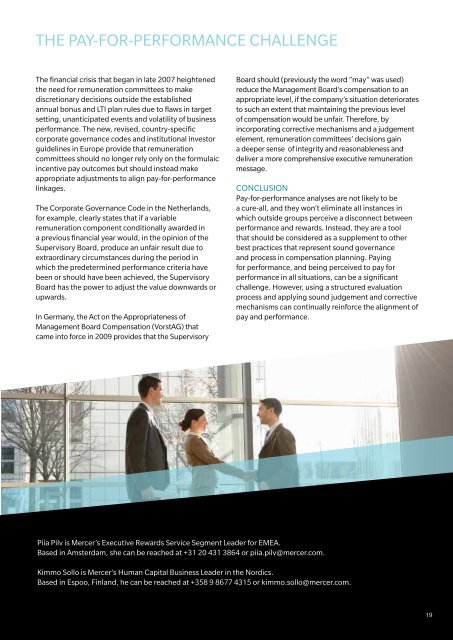A SERIES OF ARTICLES FRoM THE 2011 EMEA CoMPENSATIoN ...
A SERIES OF ARTICLES FRoM THE 2011 EMEA CoMPENSATIoN ...
A SERIES OF ARTICLES FRoM THE 2011 EMEA CoMPENSATIoN ...
Create successful ePaper yourself
Turn your PDF publications into a flip-book with our unique Google optimized e-Paper software.
<strong>THE</strong> PAY-FOR-PERFORMANCE CHALLENGE<br />
The financial crisis that began in late 2007 heightened<br />
the need for remuneration committees to make<br />
discretionary decisions outside the established<br />
annual bonus and LTI plan rules due to flaws in target<br />
setting, unanticipated events and volatility of business<br />
performance. The new, revised, country-specific<br />
corporate governance codes and institutional investor<br />
guidelines in Europe provide that remuneration<br />
committees should no longer rely only on the formulaic<br />
incentive pay outcomes but should instead make<br />
appropriate adjustments to align pay-for-performance<br />
linkages.<br />
The Corporate Governance Code in the Netherlands,<br />
for example, clearly states that if a variable<br />
remuneration component conditionally awarded in<br />
a previous financial year would, in the opinion of the<br />
Supervisory Board, produce an unfair result due to<br />
extraordinary circumstances during the period in<br />
which the predetermined performance criteria have<br />
been or should have been achieved, the Supervisory<br />
Board has the power to adjust the value downwards or<br />
upwards.<br />
In Germany, the Act on the Appropriateness of<br />
Management Board Compensation (VorstAG) that<br />
came into force in 2009 provides that the Supervisory<br />
Board should (previously the word “may” was used)<br />
reduce the Management Board’s compensation to an<br />
appropriate level, if the company’s situation deteriorates<br />
to such an extent that maintaining the previous level<br />
of compensation would be unfair. Therefore, by<br />
incorporating corrective mechanisms and a judgement<br />
element, remuneration committees’ decisions gain<br />
a deeper sense of integrity and reasonableness and<br />
deliver a more comprehensive executive remuneration<br />
message.<br />
CONCLUSION<br />
Pay-for-performance analyses are not likely to be<br />
a cure-all, and they won’t eliminate all instances in<br />
which outside groups perceive a disconnect between<br />
performance and rewards. Instead, they are a tool<br />
that should be considered as a supplement to other<br />
best practices that represent sound governance<br />
and process in compensation planning. Paying<br />
for performance, and being perceived to pay for<br />
performance in all situations, can be a significant<br />
challenge. However, using a structured evaluation<br />
process and applying sound judgement and corrective<br />
mechanisms can continually reinforce the alignment of<br />
pay and performance.<br />
Piia Pilv is Mercer’s Executive Rewards Service Segment Leader for <strong>EMEA</strong>.<br />
Based in Amsterdam, she can be reached at +31 20 431 3864 or piia.pilv@mercer.com.<br />
Kimmo Sollo is Mercer’s Human Capital Business Leader in the Nordics.<br />
Based in Espoo, Finland, he can be reached at +358 9 8677 4315 or kimmo.sollo@mercer.com.<br />
21 19
















